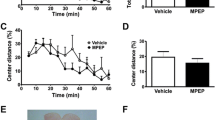Chronic experiments on rats addressed the effects of blockade of NMDA and metabotropic glutamate receptors in the neostriatum on conditioned reflex avoidance (in a shuttle box) and spontaneous (in an open field) behavior. Glutamate receptor antagonists were given bilaterally into the neostriatum, in some experiments with the GABAA receptor antagonist picrotoxin (2 μg), which impairs execution of conditioned reflex skills and produces choreomyoclonic hyperkinesia. The most effective agent in preventing the adverse effects of picrotoxin on behavior was the type 5 metabotropic receptor antagonist MTEP (3 μg), which when given into the neostriatum without picrotoxin had no effect on measures of avoidance behavior and did not alter the level of spontaneous motor activity. In contrast, the type 1 metabotropic receptor antagonist EMQMCM (3 μg) degraded measures of normal motor behavior (indicative of a sedative effect) but did not prevent the actions of picrotoxin. The NMDA receptor antagonist MK-801 (dizocilpine, 1 and 5 μg) decreased picrotoxin-induced hyperkinesia but had only mild effects on its adverse influence on conditioned reflex activity; given alone into the striatum, it decreased normal motor activity. Considering the distributions of the study receptors on neostriatal neuron membranes, it is suggested that the most effective action, on type 5 glutamate receptors, may be linked with their involvement in supporting the activity of the “indirect” efferent pathway, the activity of which is impaired in the hyperkinetic type of dysfunction of the extrapyramidal motor system in Huntington’s chorea in humans.
Similar content being viewed by others
References
N. I. Dubrovina and D. R. Zinov’ev, “Effects of Dizocilpine on quenching of a conditioned passive avoidance reaction in mice with a depression-like state,” Byul. Sib. Otd. Rus. Akad. Med. Nauk., 125, No. 3, 25–29 (2007).
S. N. Illarioshkin, Conformational Diseases of the Brain,, Yanus-K, Moscow (2003).
Yu. A. Novitskaya, O. A. Dravolina, E. E. Zvartau, and V. Danish, “Interaction of ionotropic NMDA receptor blockers and metabotropic glutamate receptors in a working memory test in rats,” Zh. Vyssh. Nerv. Deyat., 59, No. 4, 446–452 (2009).
I. G. Sil’kis, “Interaction of biochemical process in striatal neurons evoked by activation of excitatory, inhibitory, and dopamine inputs,” Ros. Fiziol. Zh., 86, No. 5, 507–518 (2002).
N. F. Suvorov and V. T. Shuvaev, “Involvement of the basal ganglia in organizing behavior,” Ros. Fiziol., 88, No. 10, 1233–1240 (2002).
A. F. Yakimovskii, “A method for prolonged local actions on neurotransmitter systems in the nuclei of the brain,” Fiziol. Zh. SSSR, 74, No. 3, 745–751 (1988).
A. F. Yakimovskii, “Myoclonic hyperkinesia induced by repeated administration of picrotoxin into the neostriatum in rats,” Byull. Eksperim. Biol. Med., 114, No. 1, 7–9 (1993).
A. F. Yakimovskii, “Functional specialization of transmitter systems as the basis for the multifunctionality of the neostriatum,” Ros. Fiziol. Zh., 84, No. 9, 906–912 (1998).
D. M. Ashby, D. Habib, H. C. Dringenberg, et al., “Subchronic MK-801 treatment and post-weaning social isolation in rats: differential effects on locomotor activity and hippocampal long-term potentiation,” Behav. Brain Res., 212, No. 1, 64–70 (2010).
I. Bezprozvanny and M. R. Hayden, “Deranged neuronal calcium signaling and Huntington disease,” Biochem. Biophys. Res. Commun., 322, No. 4, 1310–1317 (2004).
P. Calabresi, D. Centonze, P. Gubellini, et al., “Synaptic transmission in the striatum: from plasticity to neurodegeneration,” Progr. Neurobiol., 61, No. 3, 231–265 (2000).
P. J. Conn, G. Battaglia, M. J. Marino, and F. Nicoletti, “Metabotropic glutamate receptors in the basal ganglia motor circuit,” Nat. Rev. Neurosci., 6, No. 10, 787–798 (2005).
F. Ferraguti, L. Crepaldi, and F. Nicoletti, “Metabotropic glutamate 1 receptor: current concepts and perspectives,” Pharmacol. Rev., 60, No. 4, 536–581 (2008).
A. Galvan, M. Kuwajima, and Y. Smith, “Glutamate and GABA receptors and transporters in the basal ganglia: What does their subsynaptic localization reveal about their function?” Neuroscience, 143, No. 2, 351–375 (2006).
A. Gravius, B. Pietraszeka, D. Schafera, et al., “Effects of mGlu1 and mGlu5 receptor antagonists on negatively reinforced learning,” Behav. Pharmacol., 16, No. 2, 113–121 (2005).
A. M. Graybiel, “The basal ganglia and chunking of action repertoires,” Neurobiol. Learn. Mem., 70, No. 2, 119–136 (1998).
Y.-J. I. Jong, V. Kumar, A. E. Kingston, et al., “Functional metabotropic glutamate receptors on nuclei from brain and primary cultured striatal neurons: role of transporters in delivering ligand,” J. Biol. Chem., 280, No. 34, 30,469–30,480 (2005).
H. Kalonia, P. Kumar, B. Nehru, and A. Kumar, “Neuroprotective effect of MK-801 against intra-striatal quinolinic acid induced behavioral, oxidative stress and cellular alterations in rats,” Ind. J. Exp. Biol., 47, No. 11, 880–892 (2009).
M. Paquet and Y. Smith, “Group I metabotropic glutamate receptors in the monkey striatum: subsynaptic association with glutamatergic and dopaminergic afferents,” J. Neurosci., 23, No. 20, 7659–7669 (2003).
A. Pisani, P. Bonsi, D. Centonze, et al., “Targeting striatal cholinergic interneurons in Parkinson’s disease: focus on metabotropic glutamate receptors,” Neuropharmacology, 456, No. 11, 45–56 (2003).
S. Y. Sakurai, J.-H. J. Cha, J. B. Penney, and A. B. Young, “Regional distribution and properties of [3H]MK-801 binding sites determined by quantitative autoradiography in rat brain,” Neuroscience, 40, No. 2, 533–543 (1991).
Y. Smith, A. Charara, M. Paquet, et al., “Ionotropic and metabotropic GABA and glutamate receptors in primate basal ganglia,” J. Chem. Neuroanat., 22, No. 1, 13–42 (2001).
Author information
Authors and Affiliations
Corresponding author
Additional information
Translated from Rossiiskii Fiziologicheskii Zhurnal imeni I. M. Sechenova, Vol. 99, No. 2, pp. 221–229, February, 2013.
Rights and permissions
About this article
Cite this article
Yakimovskii, A.F., Kerko, T.V. Comparative Analysis of the Effects of Blockade of Striatal Metabotropic and Ionotropic Glutamate Receptors on Motor Behavior in Rats. Neurosci Behav Physi 44, 1014–1019 (2014). https://doi.org/10.1007/s11055-014-0018-z
Received:
Revised:
Published:
Issue Date:
DOI: https://doi.org/10.1007/s11055-014-0018-z



